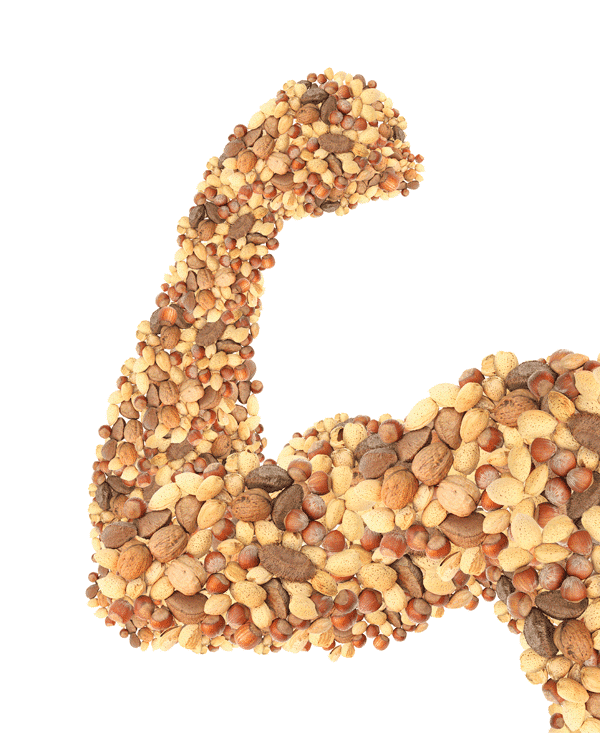You Are What You Eat

Part One: The Basic Building Blocks
You are what you eat. Sound familiar? I’m sure you have heard the expression. After all, it rings true; good in, good out. No other organ demonstrates this better than the brain. The average human brain is about three pounds, which makes it only two percent of the total body weight for a 150 pound person; however, the brain uses a whopping 20% of the blood flow and oxygen in your body! Pretty selfish, eh? Well, now hold on there. Your brain pulls its weight. It is, quite literally, the brains of the operation. So, sit back and enjoy some brain food about brain food.
At Interactive Metronome, we are committed to your brain. Brains are kind of our thing. We want to be in a long-term relationship with your brain, and we want it to be healthy for years to come. While we are not advocating any particular diet, there are definitely good and bad things to eat. Everything you eat plays a role in your overall health, but here are a few of the important nutrients for the brain:
· Complex Carbohydrates: Low carb, no carb. You hear it all the time, but it isn’t always how much you eat; in this instance, it is what type you eat. Simple sugars might be easy to use, but they are inefficient and short-lived. Complex carbohydrates can give your body slow, regulated energy, which is important to balance metabolism, mood swings, tiredness, blood sugar and weight. Your brain needs glucose, and complex carbohydrates can be broken down into glucose. Dietary experts don’t fully agree on a number, but somewhere between 45-75% of total energy consumption should come from carbohydrates (only 10% of which should come from simple sugars such as refined sugar, high fructose corn syrup, and surprisingly, most fruits).
Sources: Brown Rice, Quinoa, Whole-Grain Bread, Potatoes, Beans and Lentils
· Fats: We all know not to eat a lot of fat, but here again it may matter more what kind of fats you eat. There is fat in brain cell membranes and neurons. Vitamins A, D, E and K are fat soluble, which means our bodies can only use them with fat. Fats insulate the brain, helping to protect it from shock and maintain temperature. Fats can also be broken down into fatty acids and glycerol; glycerol can be broken down into glucose, a.k.a. brain fuel.
Sources: Olive Oil, Nuts, Seeds, Butter, Animal Fat
· Fatty Acids: Not a fat! In fact, when originally discovered in the 1920’s, they were listed as vitamins, but later research showed they had more in common with fats. Regardless, these wonderful little acids are an essential part of brain function. DHA, a form of omega-3 fatty acid, makes up a large portion of your brain’s grey matter. The transmission of electrical signals across the synapses is dependent on fatty acids. Fatty acid levels also affect serotonin neurotransmitter levels, which control mood and sleep.
Sources: Wild Salmon, Flax Seeds, Kidney Beans, Spinach, Mangoes and Papayas
· Protein: Protein is second only to water in percentage of total body weight. Everything in our bodies is made of proteins. And although it is true that the brain is made up mostly of fat, the building blocks of neurotransmitters are amino acids. Amino acids make up proteins, and our bodies know how to pull them apart and build them again. There are 22 amino acids that humans use to construct various body parts; eight of these amino acids must come from our diet (essential) and the other 14 (non-essential) can be produced”¦albeit mostly by using essential amino acids. Of those amino acids, two (tryptophan and tyrosine) affect mood and energy levels. Eating a morning meal high in protein will cause a spike in tyrosine levels, wich will trigger a release of norepinephrine and dopamine, both of which promote alertness and energy. Conversely, tryptophan will win out if you eat a large dose of carbohydrates. Tryptophan will cause a release of serotonin, which can make you tired.
Sources: Chicken Breast, Milk, Cheese, Eggs, Yogurt, Soy and other Beans
o L-glutamine is the most abundant non-essential free amino acid in the blood. While much of the research on l-glutamine is related to the treatment of trauma, burns, injuries and intense athletic performance, some studies show a strong link to intelligence, equilibrium, alertness and memory. Low levels of l-glutamine have also been found in children with ADHD. Additionally, l-glutamine is the precursor of GABA, a calming and mood stabilizing amino acid. GABA can stop the brain’s synapses from over-firing, prevent stress-related messages from reaching motor centers of the brain, relieve pain, improve sleep and help regulate blood pressure. GABA has been studied as a treatment for epilepsy, bipolar disorders, anxiety, schizophrenia, dementia and cancer.
Sources: Wheat Germ, Eggs, Oats, Lean Beef, Eggs, Spinach and Cabbage
Clearly, what you eat has a major impact on overall brain health and function. Just think, we haven’t even gotten to vitamins, minerals, trace compounds and water. Gosh, there is so much to talk about. We could go on for hours, but we won’t. Right now, it is time to go get some lunch, but be sure to check back soon for more food for thought.
Check out more on nutrition here…
Part III – Heavy Metal, Rock and Your Health
Part IV – Dietary Change: How eating metal can help your brain and body
